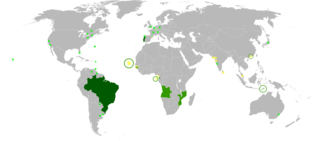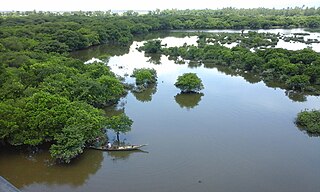| Taim Ecological Station | |
|---|---|
| Estação Ecológica do Taim | |
IUCN category Ia (strict nature reserve) | |
Lagoa Mirim —Merín Lagoon, near the Taim Ecological Station | |
| Coordinates | 32°32′S52°32′W / 32.54°S 52.54°W Coordinates: 32°32′S52°32′W / 32.54°S 52.54°W |
| Area | 10,939 hectares (27,030 acres) |
| Designation | ecological station |
| Created | 21 July 1986 |
| Designated | 22 March 2017 |
| Reference no. | 2298 [1] |
The Taim Ecological Station (Portuguese : Estação Ecológica do Taim) is a federally-administered ecological station in the state of Rio Grande do Sul, Brazil.

Portuguese is a Western Romance language originating in the Iberian Peninsula. It is the sole official language of Portugal, Brazil, Cape Verde, Guinea-Bissau, Mozambique, Angola, and São Tomé and Príncipe. It also has co-official language status in East Timor, Equatorial Guinea and Macau in China. As the result of expansion during colonial times, a cultural presence of Portuguese and Portuguese creole speakers are also found in Goa, Daman and Diu in India; in Batticaloa on the east coast of Sri Lanka; in the Indonesian island of Flores; in the Malacca state of Malaysia; and the ABC islands in the Caribbean where Papiamento is spoken, while Cape Verdean Creole is the most widely spoken Portuguese-based Creole. A Portuguese-speaking person or nation may be referred to as "Lusophone" in both English and Portuguese.

An ecological station in Brazil is a type of protected area of Brazil as defined by the National System of Conservation Units (SNUC). The purpose is to preserve untouched representative samples of the different biomes in Brazil.

Rio Grande do Sul is a state located in the southern region of Brazil. It is the fifth most populous state and the ninth largest by area. Located in the southernmost part of the country, Rio Grande do Sul is bordered clockwise by Santa Catarina to the north and northeast, the Atlantic Ocean to the east, the Uruguayan departments of Rocha, Treinta y Tres, Cerro Largo, Rivera and Artigas to the south and southwest, and the Argentine provinces of Corrientes and Misiones to the west and northwest. The capital and largest city is Porto Alegre. The state has the highest life expectancy in Brazil, and the crime rate is considered to be low.















